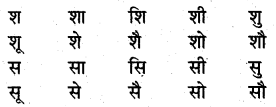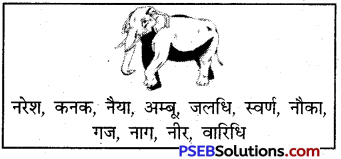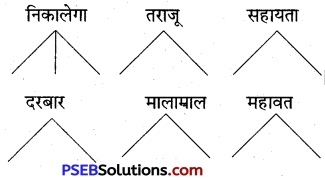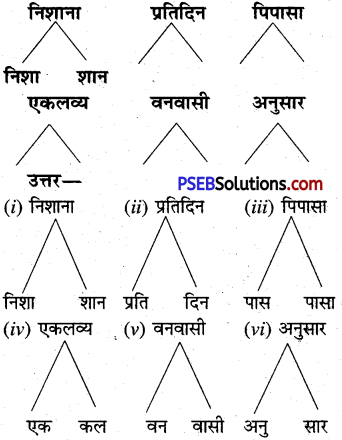Punjab State Board PSEB 5th Class Hindi Book Solutions Chapter 3 नगर की सुंदरता Textbook Exercise Questions and Answers.
PSEB Solutions for Class 5 Hindi Chapter 3 नगर की सुंदरता
Hindi Guide for Class 5 PSEB नगर की सुंदरता Textbook Questions and Answers
I. बताओ
प्रश्न 1.
महाराज कृष्णदेव क्या करना चाहते थे?
उत्तर:
महाराज कृष्णदेव विजयनगर को अत्यधिक साफ़-सुथरा और सुन्दर बनाना चाहते थे।
प्रश्न 2.
सैलानियों का समूह क्यों उमड़ आया ?
उत्तर:
सैलानियों का समूह विजयनगर की सन्दरता को देखने के लिए उमड आया।
![]()
प्रश्न 3.
राजा के पूछने पर तेनालीराम क्यों चुप रहे?
उत्तर;
तेनालीराम राजा के किए गए कार्यों से खुश नहीं थे इसीलिए वह चुप रहे।
प्रश्न 4.
कृष्णदेव ने कमी सिद्ध न कर पाने पर क्या शर्त बतायी ?
उत्तर:
कमी सिद्ध न कर पाने पर कृष्णदेव ने तेनालीराम को मृत्यु दण्ड की शर्त बतायी।
प्रश्न 5.
जय-जयकार करने वाले लोम कौन थे ?
उत्तर:
जय-जयकार करने वाले लोग मंत्रियों के चमचे थे।
प्रश्न 6.
बस्ती के लोगों की कैसी दशा थी ?
उत्तर:
बस्ती के लोगों की दशा अच्छी नहीं थी। वे लोग तरह-तरह की बीमारियों से ग्रस्त थे।
प्रश्न 7.
प्रजा के सुन्दर जीवन के लिए राजा ने क्या आदेश दिया ?
उत्तर:
प्रजा. के सुन्दर जीवन के लिए राजा ने बस्ती को साफ़ करवाने, बीमारों का इलाज करवाने और बढ़े हुए करों को वापिस लेने का आदेश दिया।
प्रश्न 8.
इस कहानी से क्या सन्देश मिलता है ?
उत्तर:
यह कहानी सन्देश देती है कि श्रेष्ठ राजा वह है जो प्रजा के हितों का ध्यान रखे। असली सुन्दरता प्रजा के खिले हुए चेहरे हैं।
II. विलोम शब्द लिखो
(i) राजा : रंक
(ii) दुःखी : ……………
(iii) सुन्दर : ……………
(iv) अन्धेरा : ……………
(v) विजय : ……………
(vi) गन्दगी : ……………
(vii) सम्मान : ……………
(viii) उपस्थित : ……………
उत्तर:
विलोम शब्द
(i) राजा = रंक।
(ii) दुःखी = सुखी।
(iii) सुन्दर = कुरूप।
(iv) अन्धेरा = उजाला।
(v) विजय = पराजय।
(vi) गन्दगी = सफ़ाई।
(vii) सम्मान = अपमान।
(viii) उपस्थित = अनुपस्थित।
III. समानार्थक शब्द लिखें
(i) राजा = नरेश।
(ii) जीवन = ……………।
(iii) खुशी = ……………।
(iv) सैलानी = ……………।
(v) मृत्यु = ……………।
(vi) प्रश्न = ……………।
उत्तर:
समानार्थक शब्द:
(i) राजा = नरेश।
(ii) जीवन = ज़िन्दगी।
(iii) खशी = प्रसन्नता।
(iv) सैलानी = पर्यटक।
(v) मृत्यु = मरण।
(vi) प्रश्न = सवाल।
![]()
IV. संज्ञा शब्द छाँटकर लिखो
1. मुझे लगता है ये विजयनगर की सुन्दरता से खुश नहीं है।
2. तेनालीराम ने अपनी चुप्पी तोड़ते हुए कहा।
3. महाराज की खुशी का ठिकाना न रहा।
4. प्रजा में कोई उत्साह नहीं दिखाई दिया।
उत्तर:
संज्ञा शब्द:
(1) (i) विजयनगर-(व्यक्तिवाचक संज्ञा)
(ii) सुन्दरता-(भाववाचक संज्ञा)।
(2) (i) तेनालीराम-(व्यक्तिवाचक संज्ञा)।
(ii) चुप्पी-(भाववाचक संज्ञा)
(3) (i) महाराज-(जातिवाचक संज्ञा)
(ii) खुशी-(भाववाचक संज्ञा)।
(4) (i) प्रजा-(जातिवाचक संज्ञा)
(ii) उत्साह-(भाववाचक संज्ञा)।
V. दिए गए शब्दों से नए शब्द बनाइए
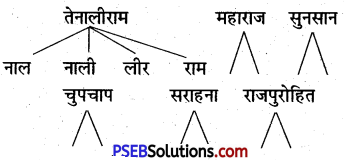
उत्तर:
(i) तेनालीराम-(i) नाल (ii) नाली (iii) लीर (iv) राम।
(ii) महाराज-(i) महा (ii) राज।
(iii) सुनसान-(i) सुन (ii) सान।
(iv) चुपचाप-(i) चुप (ii) चाप।
(v) सराहना-(i) सर (ii) राह।
(vi) राजपुरोहित-(i) राज (ii) पुर (iii) हित (iv) पुरोहित (v) रोहित।
VI. निम्नलिखित मुहावरों को वाक्यों में प्रयोग करो
मुहावरा – अर्थ – वाक्य
1. उमड़ पड़ना – जोश में आ जाना – ……………
2. दिल रो पड़ना – अफसोस होना – …………..
3. खुशी का ठिकाना न रहना – बहुत खुश होना – …………..
4. एक स्वर में कहना – मिलकर कहना – ………….
5. चुप्पी तोड़ना – मौन तोड़ना, बोलना – …………….
उत्तर:
(i) उमड़ पड़ना – जोश में आ जाना – नेता के आते ही जनता उन्हें देखने के लिए उमड़ पड़ी।
(ii) दिल रो पड़ना – अफसोस होना – भिखारी की दयनीय दशा देखकर मेरा दिल रो पड़ा।
(iii) खुशी का ठिकाना न रहना – बहुत खुश होना – परीक्षा में प्रथम आने का समाचार पाते ही मेरी ख़ुशी का ठिकाना न रहा।
(iv) एक स्वर में कहना – मिलकर कहना – सभी विद्यार्थियों ने मिलकर एक स्वर में कहा-हम नशावृति से दूर रहेंगे।
(v) चुप्पी तोड़ना – मौन तोड़ना, बोलना – सभा में सभी चुपचाप, शान्त भाव से बैठे थे। संन्यासी जी ने चुप्पी तोड़ते हुए बोलना आरम्भ किया।
VII. निम्नलिखित के विराम चिह्न लगाएँ
1. महाराज तेनालीराम चुपचाप बैठे हैं।
2. कैसी कमी महाराज ने हैरानी से पूछा
3. लेकिन तुम गुमसुम क्यों हो
4. काश मंत्री लोग प्रजा की सुविधाओं पर ध्यान देते
उत्तर:
विराम चिह्न
(i) “महाराज! तेनालीराम चुपचाप बैठे हैं।”
(ii) “कैसी कमी ?” महाराज ने हैरानी से पूछा।
(iii) लेकिन तुम गुमसुम क्यों हो ?
(iv) काश! मंत्री लोग प्रजा की सुविधाओं पर ध्यान देते।
VIII. निम्नलिखित शब्दों में अन्तर समझें और वाक्यों में प्रयोग करें
1. चमचा : चम्मच
चमचा.: चापलूसी करने वाला
2. अमल : नशा
अमल : काम, क्रिया, व्यवहार
3. चक्कर : मोड़, घुमाव
चक्कर : उलझन
4. नक्शा : रंगरूप, बनावट
नक्शा : मानचित्र।
उत्तर:
(1) (i) चमचा = चम्मच → कृपया मुझे एक चमचा देना।
(ii) चमचा = चापलूसी करने वाला → मुकेश तो साहब का चमचा है।
(2) (i) अमल = नशा → दिनेश को शराब का अमल लग गया है।
(ii) अमल = पालन करना, व्यवहार → मैं आपके विचारों पर अमल करूंगा।
![]()
(3) (i) चक्कर = मोड़, घुमाव → पहाड़ी रास्ता चक्करदार है।
(ii) चक्कर = उलझन → मैं इस चक्कर में नहीं पड़ना चाहता।
(4) (i) नक्शा = रंगरूप, बनावट → उसके नाक-नक्श बहुत तीखे हैं।
(ii) नक्शा = मानचित्र → मुझे पंजाब का नक्शा देना।
IX. कुछ करने को
किसी बस्ती में अपने अभिभावक / अध्यापक के साथ जाकर वहाँ के लोगों की दशा और बस्ती की दशा पर अपने विचार लिखें। आप उसके सुधार के लिए क्या करेंगे ?
उत्तर:
विद्यार्थी स्वयं प्रयास करें।
बहुवैकल्पिक प्रश्न
पूछे गए प्रश्नों के सही विकल्प पर (✓) निशान लगाएं
प्रश्न 1.
विजयनगर के राजा कौन थे ?
(क) कृष्णदेव
(ख) विजय देव
(ग) विजय सिंह
(घ) कृष्ण सिंह।
उत्तर:
(क) कृष्णदेव
प्रश्न 2.
महाराज कृष्णदेव विजयनगर को कैसा बनाना चाहते थे.?
(क) सुरमय
(ख) सुशील
(ग) सुन्दर
(घ) सुनहरा।
उत्तर:
(ग) सुन्दर
प्रश्न 3.
विजय को देखने के लिए कौन आए ?
(क) राजा
(ख) सैलानी
(ग) मंत्री
(घ) प्रजा।
उत्तर:
(ख) सैलानी
प्रश्न 4.
मंत्री और चमचे राजा की क्या करते थे ?
(क) जय-जयकार
(ख) नमस्ते
(ग) दुहाई
(घ) बुराई।
उत्तर:
(क) जय-जयकार
प्रश्न 5.
एक श्रेष्ठ राजा किसके हितों का ध्यान रखता
(क) प्रजा
(ख) धनी
(ग) पैसे वाले
(घ) लुटेरों।
उत्तर:
(क) प्रजा
नगर की सुंदरता Summary
नगर की सुंदरता पाठ का सार
महाराज कृष्णदेव विजयनगर को साफ़-सुथरा और सुन्दर बनाना चाहते थे। उन्होंने अपने मन्त्री को अपनी इच्छा बताई। महाराज की आज्ञा का पालन करते हुए मन्त्री विजयनगर को सजाने-सँवारने में लग गया। कुछ ही दिनों में विजयनगर की सुन्दरता की चर्चा दूर-दूर तक होने लगी। दूर-दूर से लोग उसकी सुन्दरता को देखने के लिए आने लगे। इससे महाराज बहुत ही खुश हुए। उन्होंने विजयनगर की सुन्दरता के बारे में दरबारियों की राय माँगी तो सभी दरबारियों ने एक ही स्वर में कहा कि विजयनगर की सुन्दरता में हमें कोई कमी नहीं दिखाई। देती। सभी ने विजयनगर की प्रशंसा की, लेकिन तेनालीराम चुपचाप बैठा रहा। उसे चुप बैठे देखकर महाराज ने कहा, “तेनालीराम, चारों ओर विजयनगर की प्रशंसा हो रही है, लेकिन तुम गुमसुम क्यों हो ?” तेनालीराम ने कहा कि महाराज विजयनगर की सुन्दरता में कुछ कमी रह गई है।
![]()
महाराज के पूछे जाने पर कि क्या कमी रह गई है, तेनालीराम ने इसके उत्तर में कहा कि उस कमी को देखने के लिए आपको मेरे साथ नगर का भ्रमण करना पड़ेगा। महाराज ने कहा कि यदि तुम कमी को सिद्ध नहीं कर पाए तो तुम्हें मृत्यु दण्ड दिया जाएगा। तेनालीराम महाराज को लेकर एक बस्ती की ओर गये। बस्ती में पहुँचने पर मंत्रियों के चमचे तो महाराज की जय-जयकार करने लगे, लेकिन प्रजा में कोई उत्साह नहीं था। आगे बढ़ने पर महाराज ने अँधेरा ही अँधेरा देखा, वहाँ का माहौल बहुत-ही गन्दा था, लोग तरह-तरह की बीमारियों से पीड़ित थे। प्रजा को दुखी देखकर महाराज का दिल रो पड़ा। उन्होंने दुखी होकर तेनालीराम की ओर देखा। तेनालीराम ने बताया कि नगर को सुन्दर बनाने के प्रयास में प्रजा की अनदेखी हुई है। महाराज ने तुरन्त आदेश दिया कि प्रजा के सुन्दर जीवन के बिना विजयनगर की सारी सुन्दरता बेकार है। अत: नगर की गन्दी बस्तियों को साफ़ किया जाए, बीमारों का इलाज करवाया जाए और बढ़े हुए करों को वापिस ले लिया जाए। महाराज के आदेश को तुरन्त अमल में लाया गया। नगर को सुन्दर बनाने का अभियान चल पड़ा। तेनालीराम का भी बहुत मान-सम्मान होने लगा।
कठिन शब्दों के अर्थ:
अत्यधिक = बहुत ज्यादा। इच्छा = लालसा। अवगत = जानकारी। आदेश = आज्ञा। बखान = प्रशंसा। सैलानियों = पर्यटकों। समूह = झुण्ड, जत्था। उपस्थित = मौजूद, हाज़िर। सराहना = प्रशंसा, तारीफ। आश्चर्यचकित = हैरान। भ्रमण = सैर। घृणा = नफ़रत।
